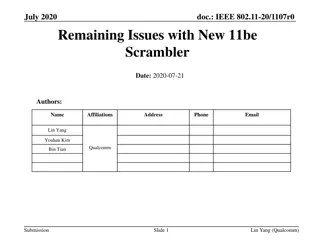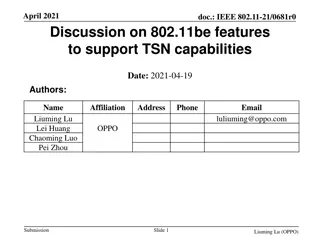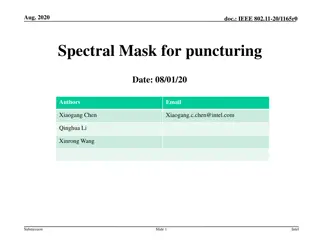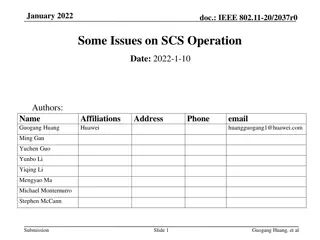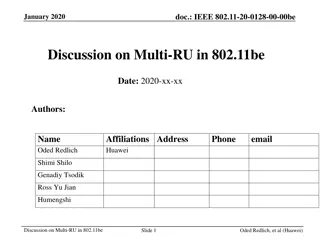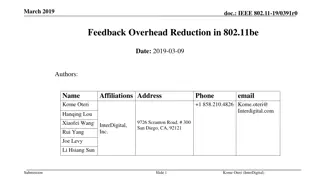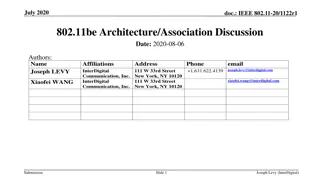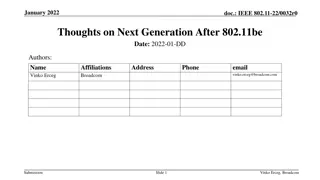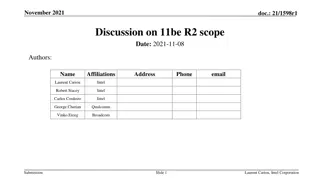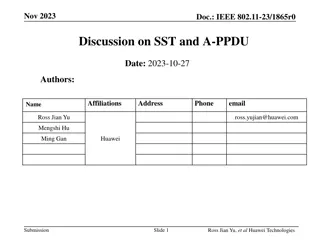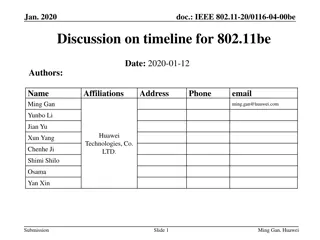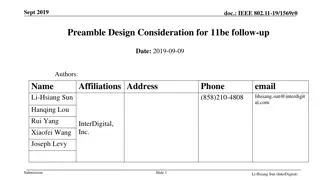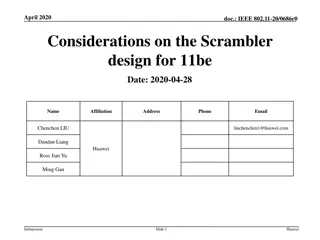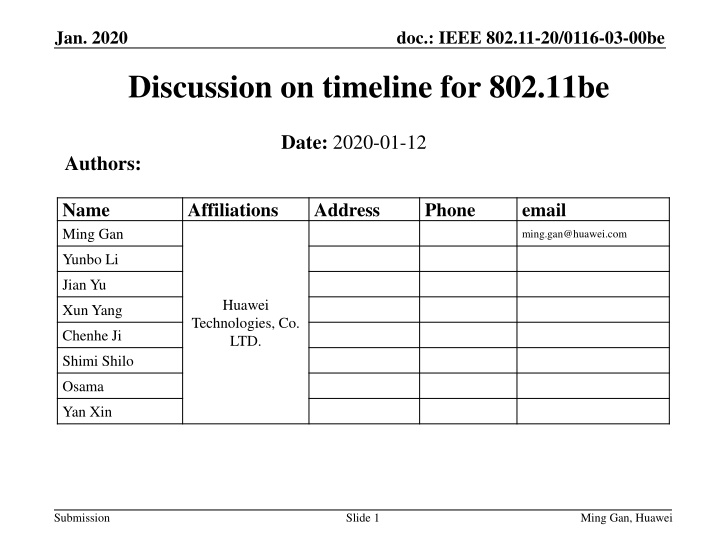
Discussion on Timelines for IEEE 802.11be Development
Explore the discussion on timelines for IEEE 802.11be development, considering split features, market expectations, and technology advancements. Delve into the importance of time-to-market, multi-phase releases, and competitive standards in driving amendments and decisions.
Download Presentation

Please find below an Image/Link to download the presentation.
The content on the website is provided AS IS for your information and personal use only. It may not be sold, licensed, or shared on other websites without obtaining consent from the author. If you encounter any issues during the download, it is possible that the publisher has removed the file from their server.
You are allowed to download the files provided on this website for personal or commercial use, subject to the condition that they are used lawfully. All files are the property of their respective owners.
The content on the website is provided AS IS for your information and personal use only. It may not be sold, licensed, or shared on other websites without obtaining consent from the author.
E N D
Presentation Transcript
Jan. 2020 doc.: IEEE 802.11-20/0116-03-00be Discussion on timeline for 802.11be Date: 2020-01-12 Authors: Name Ming Gan Affiliations Address Phone email ming.gan@huawei.com Yunbo Li Jian Yu Huawei Xun Yang Technologies, Co. LTD. Chenhe Ji Shimi Shilo Osama Yan Xin Submission Slide 1 Ming Gan, Huawei
Jan. 2020 doc.: IEEE 802.11-20/0116-03-00be Background Reference [1] proposed to split the features into the two phases by the following motivations development of 802.11 should respect the timeline Market expectation is already built based on the timeline Moreover, in [1] it also points out that contributions on the features in release 1 should be prioritized Only the features in release 1 would be converted from SFD into spec text in D0.1/1.0 No need to pay much attention to other features The feature selection criteria for release 1[1] Complexity/gain tradeoff Time to standardize time/investment to implement Market needs Interest in the features Submission Slide 2 Ming Gan, Huawei
Jan. 2020 doc.: IEEE 802.11-20/0116-03-00be Background Based on the feature selection criteria, the selected features for release 1 listed in [1] are as follows 320 MHz bandwidth 4K QAM, multiple RUs to a single STA, multi-link operation In this contrition, we would like to show our view on this topic Drive amendments from technology side, not procedure and timeline We will discuss this topic from the following aspects Timeline/Time to market Multi-release development Minimum requirement of the PAR and FRD Competitive Submission Slide 3 Ming Gan, Huawei
Jan. 2020 doc.: IEEE 802.11-20/0116-03-00be Timeline/Time to market The first questions, could the time to market/timeline be the only motivation to split the features into different phases? Was there any related discussion before? Actually, splitting the features was discussed in an early stage of 802.11 ax (see reference [2]), and did not reach an agreement. The author proposed to split the features into 2 waves to speed up the first wave, and used the same criteria to select the features The author also mentioned that draft 1.0 should focus on providing a mature spec for the features targeted at 11ax wave 1 The results of straw poll was: Y 39, N 18, A 62 Today it shows that proposal [1] is not necessary given the success of 802.11ax The timeline in 802.11 ax was adjusted again and again to satisfy the technology development Many features were included in 802.11ax, such as OFDMA, UL MU-MIMO, SR, TWT, 1024QAM , 6GHz and so on, and they are finally finalized 11ax long track From reference 2, Laurent Cariou fast track IEEE802.11 11ax/HEW Wave 1 11ax/HEW Wave 2 WFA 2014 2019 2015 2017 2016 2018 Submission Slide 4 Ming Gan, Huawei
Jan. 2020 doc.: IEEE 802.11-20/0116-03-00be Timeline/Time to market Beside reference [2], reference [3] also raisd some discussion on timeline, the conclusion is that the timeline should be driven by what the technology will require, not imposed by an official order It points out that predicting timelines is almost always in error on the very optimistic side. Taking 11ax D1.0 for example, most people predicted the time is Jan or July 2016. However, it was done in Dec 2016 [4]. Regarding the market expectation, was that widely built? First, the market is busy deploying the WiFi 6 products in a large scale, and does not have enough time to consider full-fledged Wi-Fi 7 features Second, there are just some limited number of sources, e.g. [5][6] which mentioned Wi-Fi market expectation If we say some references [5] [6] already built market expectation for timeline, then they also built market expectation for the five competitive features in the PAR[7] Because they also mentioned the features in the PAR Some chip vendors or OEM may also benefit from the predictable features Slide 5 Submission Ming Gan, Huawei
Jan. 2020 doc.: IEEE 802.11-20/0116-03-00be Multi-release development At the beginning of 802.11be, multi-release development was proposed to reform IEEE s process for developing amendments in [8] [9] Following the procedure of 3GPP, features show up in products based on releases (release 1, release 2, etc.), which are launched a few years apart Each release has relative short period. However, it may be premature given the following factors when developing amendments Return on investment, not only for the chip vendors but also for consumers The market needs more time to build new consumer demand Moreover, the excluded features from release 1 in [1], such as HARQ, 16ss, Multi-AP, are expected to have some changes to PHY layer design They are totally different from 6GHz in 802.11ax (a pure MAC feature) Difficult to have a smart preamble design with forward compatibility for these features Hence, multi-release development could not work well at this stage We already spent much time to limit the scope of feature candidates It also adds extra decision steps / more votes, leading to more LBs, longer CR process Slide 6 Submission Ming Gan, Huawei
Jan. 2020 doc.: IEEE 802.11-20/0116-03-00be Minimum requirement of the PAR and FRD If the multi-release development is not feasible, could release 1 (or call it WiFi 7) meet the minimum requirements of the PAR [7] and FRD [10]? Requirement : shall enable at least one mode of operation capable of supporting a maximum throughput of at least 30 Gbps, as measured at the MAC data service access point (SAP). The above minimum requirement may not be met given the proposal [1], due to the following factors Twice the bandwidth (320 MHz) actually can not double the throughput given the EIRP specified by FCC Two times or three times the number of the links also can not double the throughput given that it is not easy to implement 8 or more antennas at each STA in MLD with the limited size and obtain clear 320 MHz simultaneously 4K QAM can be ignored because it will be rarely used (especially with a large number of streams) and yields only 20% throughput gain when employed Submission Slide 7 Ming Gan, Huawei
Jan. 2020 doc.: IEEE 802.11-20/0116-03-00be Competitive Last but not the least, the selected features in release 1 in [1] are much less comparative than previous main stream WiFi specs, lacking the distinguished features to support this new generation Previous specs introduced SU-MIMO and LDPC in 11n, DL MU-MIMO and mandatory large bandwidth in 11ac, OFDMA, UL MU-MIMO and SR in 11ax However, what will we have in 802.11be if we adopt the suggested features as in [1]? It seems a relatively minor improvement. All the features are just relative simple extension, e.g., multi-RU OFDMA from single RU OFDMA in 802.11ax, multi-link from multi-band in 802.11ad Improvement in both MAC and PHY features for a new generation is desirable The excluded features from release 1 [1] , such as HARQ 16ss, are PHY features We have both PHY and MAC adhocs, but the queue of PHY is empty now while the queue of MAC is still long Based on the existing status, adding PHY features will not delay the spec development significantly Submission Slide 8 Ming Gan, Huawei
Jan. 2020 doc.: IEEE 802.11-20/0116-03-00be Conclusion In this contribution, we proposed to drive amendments from technology side, not procedure and timeline It is not necessary to split the features into different phases Adding extra decision steps / more votes may lead to more LBs, longer CR process The time of the discussion for all the features should be guaranteed. All the motions of SFD should be converted to the spec draft To guarantee the time of the discussion for all the features in the PAR, we propose to add regular F2F adhoc meeting time F2F meeting is much more efficient than teleconference call which separates the presentation and straw poll Suggest to hold regular TGbe ad hoc face-to-face meetings right before IEEE 802.11 F2F meeting Slide 9 Submission Ming Gan, Huawei
Jan. 2020 doc.: IEEE 802.11-20/0116-03-00be References [1] 11-19/2153r0, Adopting a release framework to meet timeline , L. Cariou, Jan, 2020 [2] 11-14/0617r1, Discussion on timeline for 802.11ax , L. Cariou, T. Derham, May 2014 [3]11-18/1286/r1, Predicting timelines: the track record , Sean Coffey, July 2018 [4]11-14/649/r1, 802.11ax Timeline Scenarios , Rolf de Vegt, May 2014 [5] https://www.cnet.com/news/wi-fi-6-is-barely-here-but-wi-fi-7-is-already-on-the- way/ [6] https://www.u-blox.com/en/beyond/blog/guest-blogs/wi-fi-7-next-generation- wi-fi-technology [7] IEEE 802.11-18/1231r6, 802.11 EHT proposed PAR [8]11-18/1259r1, A cascading process for major amendments , R. Stacey et al., July 2018; [9]11-18/1284r0, A proposed way forward , O. Abould-Magd et al., July 2018 [10]11-19/0722r1, Proposed TGbe Functional Requirements , Ming Gan, July 2019 Submission Slide 10 Ming Gan, Huawei
Jan. 2020 doc.: IEEE 802.11-20/0116-03-00be SP 1 Do you support to hold TGbe ad hoc face-to-face meetings right before IEEE 802.11 F2F meeting, starting from March 2020 ? Submission Slide 11 Ming Gan, Huawei
Jan. 2020 doc.: IEEE 802.11-20/0116-03-00be SP 2 Which option do you prefer for TGbe ad hoc face-to- face meetings? Option 1: 3 days in the working days Option 2: 3 days in the weekend Submission Slide 12 Ming Gan, Huawei


